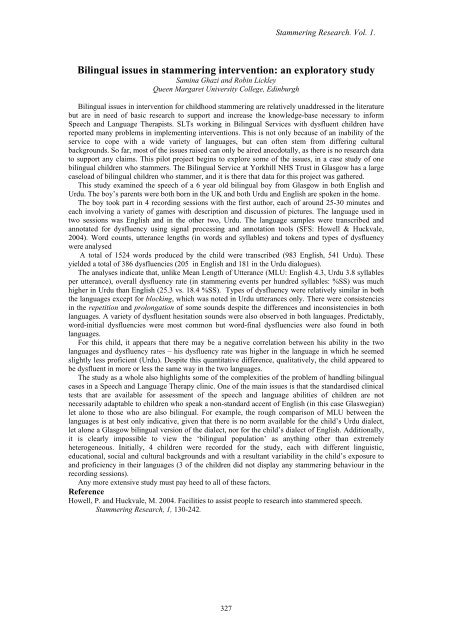Announcing 'Stammering Research' - Stammering Research - UCL
Announcing 'Stammering Research' - Stammering Research - UCL
Announcing 'Stammering Research' - Stammering Research - UCL
You also want an ePaper? Increase the reach of your titles
YUMPU automatically turns print PDFs into web optimized ePapers that Google loves.
<strong>Stammering</strong> <strong>Research</strong>. Vol. 1.<br />
Bilingual issues in stammering intervention: an exploratory study<br />
Samina Ghazi and Robin Lickley<br />
Queen Margaret University College, Edinburgh<br />
Bilingual issues in intervention for childhood stammering are relatively unaddressed in the literature<br />
but are in need of basic research to support and increase the knowledge-base necessary to inform<br />
Speech and Language Therapists. SLTs working in Bilingual Services with dysfluent children have<br />
reported many problems in implementing interventions. This is not only because of an inability of the<br />
service to cope with a wide variety of languages, but can often stem from differing cultural<br />
backgrounds. So far, most of the issues raised can only be aired anecdotally, as there is no research data<br />
to support any claims. This pilot project begins to explore some of the issues, in a case study of one<br />
bilingual children who stammers. The Bilingual Service at Yorkhill NHS Trust in Glasgow has a large<br />
caseload of bilingual children who stammer, and it is there that data for this project was gathered.<br />
This study examined the speech of a 6 year old bilingual boy from Glasgow in both English and<br />
Urdu. The boy’s parents were both born in the UK and both Urdu and English are spoken in the home.<br />
The boy took part in 4 recording sessions with the first author, each of around 25-30 minutes and<br />
each involving a variety of games with description and discussion of pictures. The language used in<br />
two sessions was English and in the other two, Urdu. The language samples were transcribed and<br />
annotated for dysfluency using signal processing and annotation tools (SFS: Howell & Huckvale,<br />
2004). Word counts, utterance lengths (in words and syllables) and tokens and types of dysfluency<br />
were analysed<br />
A total of 1524 words produced by the child were transcribed (983 English, 541 Urdu). These<br />
yielded a total of 386 dysfluencies (205 in English and 181 in the Urdu dialogues).<br />
The analyses indicate that, unlike Mean Length of Utterance (MLU: English 4.3, Urdu 3.8 syllables<br />
per utterance), overall dysfluency rate (in stammering events per hundred syllables: %SS) was much<br />
higher in Urdu than English (25.3 vs. 18.4 %SS). Types of dysfluency were relatively similar in both<br />
the languages except for blocking, which was noted in Urdu utterances only. There were consistencies<br />
in the repetition and prolongation of some sounds despite the differences and inconsistencies in both<br />
languages. A variety of dysfluent hesitation sounds were also observed in both languages. Predictably,<br />
word-initial dysfluencies were most common but word-final dysfluencies were also found in both<br />
languages.<br />
For this child, it appears that there may be a negative correlation between his ability in the two<br />
languages and dysfluency rates – his dysfluency rate was higher in the language in which he seemed<br />
slightly less proficient (Urdu). Despite this quantitative difference, qualitatively, the child appeared to<br />
be dysfluent in more or less the same way in the two languages.<br />
The study as a whole also highlights some of the complexities of the problem of handling bilingual<br />
cases in a Speech and Language Therapy clinic. One of the main issues is that the standardised clinical<br />
tests that are available for assessment of the speech and language abilities of children are not<br />
necessarily adaptable to children who speak a non-standard accent of English (in this case Glaswegian)<br />
let alone to those who are also bilingual. For example, the rough comparison of MLU between the<br />
languages is at best only indicative, given that there is no norm available for the child’s Urdu dialect,<br />
let alone a Glasgow bilingual version of the dialect, nor for the child’s dialect of English. Additionally,<br />
it is clearly impossible to view the ‘bilingual population’ as anything other than extremely<br />
heterogeneous. Initially, 4 children were recorded for the study, each with different linguistic,<br />
educational, social and cultural backgrounds and with a resultant variability in the child’s exposure to<br />
and proficiency in their languages (3 of the children did not display any stammering behaviour in the<br />
recording sessions).<br />
Any more extensive study must pay heed to all of these factors.<br />
Reference<br />
Howell, P. and Huckvale, M. 2004. Facilities to assist people to research into stammered speech.<br />
<strong>Stammering</strong> <strong>Research</strong>, 1, 130-242.<br />
327


